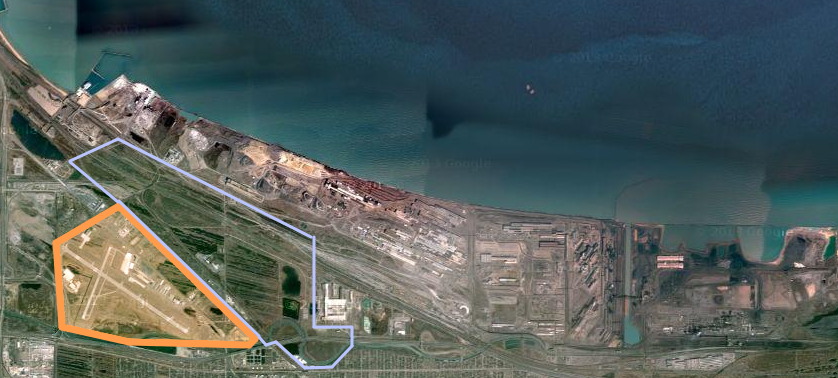NIRPC and the Great Hoosier Spirit of DIY Urbanism

Yesterday I attended NIRPC’s presentation on the updated Marquette Plan at the Carter Woodson Branch of the Gary Public Library, which was a general overview of the ongoing process of developing 34 out of Indiana’s 45 miles of lakeshore into publicly accessible nature including dunes, wetlands, trails, and some proposed new development. The plan, developed by RDA in conjunction with NIRPC and other local actors (check out RDA’s dizzying and pretty cool graphical outline of the plan), is a sort of catch-all initiative geared toward figuring out what to do with the Lake Michigan shoreline from Illinois to Michigan, paying specific attention to public access and amenities. The Great Lakes Commission also has a 2006 PowerPoint version that seems to cover much of what the presentation covered.
Rather than rehash the entire presentation, I thought I’d cover a few specific points. The plan seems fairly democratically constructed and holistically balanced across considerations of 1) historic preservation of structures in the roughly 60 square mile footprint, 2) ecological improvements, 3) public amenities including greenspace and an interconnected network of trails continuing across the entirety of the lakeshore, and 4) proposed urban development projects, remediation of industrial lands, and proposed reconfiguration of vacant, former industrial space into productive, mixed-use. The plan is currently being revised over the next few months and will be redrafted finally early next year following a public comment session, of which yesterday’s was one of several.
NIRPC regional planner Jack Eskin mentioned the West Gary Lakefront portion of the plan, which involves 1) continued development of the airport, 2) “mixed-use development” along the lakefront and former industrial lands, 3) remediation of a former coal-fired generating plant (not State Line, that’s in Hammond), and 4) partial relocation and expansion of the Kirk Yard, a Canadian National classification yard which, Eskin explained, is a huge hub for CN freight including an increasing amount of oil transport.
While “continued development of the airport” is an ongoing and somewhat vague term, the only commercial tenant having disembarked this summer, some amount of money will go into extending the runway in an attempt to lure commercial tenants, and the biggest portion of this is in remediating brownfield where the runway will go (several hundred feet at the northwest end of the runway). The cost of the relocation of the rail yard, meanwhile, is in the same ballpark as the cost of the Gary runway expansion, notable since railroads in this country actually make money while airport investment seems to be more of a gamble. But if I’ve got my math right, $161 million for 139 jobs created doesn’t work out to a great number (the Sun Times reported a still lackluster 251 jobs by 2015), and Eskin explained that the costs cover not only the physical costs of constructing new classification tracks and a new maintenance facility (currently located in Homewood’s Markham Yard) but also the “opportunity cost” of the development, since construction will delay transportation for CN. [UPDATE] Exactly how much money is being spent on what is unclear, but CN’s Homewood’s office told us by e-mail that IEDC is providing $1.5 million for the project and CN is spending $141 million, projecting that 119 full-time jobs will be added to the 186 current employees.
The presentation was understandably laced with “wouldn’t it be nice” notions, especially when talking about actual development– “TOD” projects around the South Shore NICTD stations, for example, or development on former industrial land in Gary’s lakefront, either on the east or west side of US Steel. Master planning in projects such as this one goes from “wow, that’s pretty cool” to “Well, what do we actually have the money for?” Especially in a “fiscally responsible” state like Indiana, and, more so in a county like Lake, which has all of the provincialism of rural, red-blooded Indiana but with all of the urban challenges of Chicago, the possibility of actually implementing some of these “pretty cool” parts of the plan remains questionable.

Many sections of the presentation and, indeed, answers to questions from audience members, led to the notion that if you want something done, you really should figure out how to do it yourself. One could conclude that this makes Northwest Indiana a prospective haven for DIY types; I was originally a bit puzzled by this, since NIRPC represents the entire Calumet Region and should be able to make connections across the entire region’s populace, but it highlighted an important point, that the weakness of social capital in the Region and the heavy emphasis on “macro” scale infrastructure spending, car-driven if not freight rail-driven, often leads to smaller, resident-driven (or resident-friendly) projects falling through the cracks. Communities are not walkable, and the amount of time every resident spends in a car reduces the amount of time they are interacting with each other, so it was completely unsurprising how many members of the audience (probably half a dozen) brought up issues of 1) walkable communities, 2) wanting to figure out a way to get their voices heard or collaborate with others with similar viewpoints, and 3) a need to push resident-driven projects that would actually advance the livability of these lakefront communities. (Check out this Planetizen article on so-called “DIY” urban planning that identifies the important difference between involving and empowering citizenry in the process of planning and development.)
Ending on a wholly positive note, I was encouraged by the fact that the Marquette Plan seems like an actual viable strategy to revitalize– or, really, vitalize in the first place- the lakefront, tackling for the first time that pesky issue of what to do with former industrial land as plants have consolidated, closed, or relocated. The lakefront has hosted a healthy dialectic between industrial development and naturalist concerns since it was developed in the late 1890’s and early 1900’s, so it’s safe to say that both platforms are important to the vitality and heritage of the region. Representatives from NIRPC also seemed interested in entertaining any and all possibilities since, as the MPO and project lead with RDA, they are able to aggregate not only information but also interest in collaboration. Unlike in Chicago, where less is on the table and more under the table, it appears that many options are open, but a push is needed to ensure that residents can guarantee that their goals are being satisfied (and, from my perspective, that we are pushing density north toward the Lake!). So, I am looking forward to seeing how the project grows. Public comment goes through December and the revised plan will be produced in January 2014. US Steel, unsurprisingly, decided not to send a representative to the meeting. 🙂

